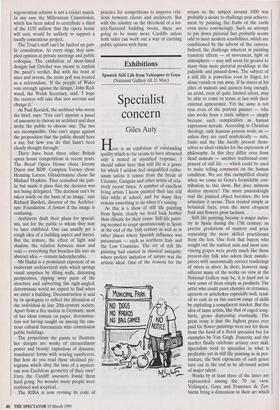Exhibitions
Spanish Still Life from Velazquez to Goya (National Gallery till 21 May)
Specialist concern
Giles Auty
Here is an exhibition of outstanding quality which so far seems to have attracted only a muted or mystified response. I should admit here that still life is a genre for which I seldom feel unqualified enthu- siasm unless it comes from the brush of Cezanne, Gauguin and other artists of rela- tively recent times. A number of excellent living artists I know painted their last still lifes while at school, and for many they remain something to do when it's raining. As this is a show of still life painting from Spain, clearly we need look further than climate for their cause. Still life paint- ing seemed to erupt spontaneously in Spain at the end of the 16th century as well as in other places where Spanish influence was paramount — such as northern Italy and the Low Countries. The art of still life painting had existed in classical antiquity, where perfect imitation of nature was the artistic ideal. One of the reasons for the return to the subject around 1600 was probably a desire to challenge past achieve- ment by painting the fruits of the earth even more convincingly. Such an attempt to pin down pictorial fact probably seems odd to most modern sensibilities, which are conditioned by the advent of the camera. Indeed, the challenge inherent in painting transient effects — of movement, light or atmosphere — may still seem far greater to many than mere pictorial proddings at the palpable and pinned-down. The subject of a still life is powerless even to fidget, let alone vanish or run away. If he stares at his piles of walnuts and quinces long enough, an artist, even of quite limited talent, may be able to come to terms at last with their external appearance. Yet the same is not true even of the portrait painter — who also works from a static subject — simply because such complexities as human expression intrude. According to Christian theology, only humans possess souls, so unless they are used symbolically — nuts, fruits and the like hardly present them- selves as ideal vehicles for the expression of philosophy. In this they differ even from dead animals — another traditional com- ponent of still life — which could be used to make telling comments on the human condition. We see this exemplified clearly when we come to Goya's formidable con- tribution to this show. But does mimesis destroy mystery? The more painstakingly real the painted object becomes, the less articulate it seems. Then treated simply as botanical facts, even the most eloquent fruit and flowers grow taciturn.
Still life painting became a major indus- try in Spain during the 17th century; its precise gradations of mastery and price separating the more skilled practitioner from the less. One feels that buyers who sought out the nuttiest nuts and most con- vincing grapes were pretty much like those present-day folk who adorn their mantle- pieces with anatomically correct renderings of otters in silver. In short, however mag- nificent many of the works on view at the National Gallery may be, it is hard not to view some of them simply as products. The artist who could paint cherries or ceramics, apricots or artichokes especially well, tend- ed to cash in on this narrow range of skills by exploiting a complacent market. But the idea of tame artists, like that of caged song- birds, grows depressing eventually. The great irony is that the highest prices ever paid for flower paintings were not for those from the hand of a floral specialist but for examples by Van Gogh. Posterity and the market finally celebrate artistry over skill. Specialists tend to specialise in what is profitable yet in still life painting as in por- traiture, the best exponents of each genre turn out in the end to be all-round artists of major talent.
Works by at least three of the latter are represented among the 70 on view. Velazquez, Goya and Francisco de Zur- baran bring a dimension to their art which is largely lacking elsewhere. The mastery displayed by Velazquez in 'An Old Woman Cooking Eggs' — painted when the artist was 19 — may suggest that the great confi- dence we have placed in art educational theorists since that time could have been misplaced. Velazquez went on to become the painter's painter par excellence, arguably the finest of all ages. Yet possibly the real treat of this show will lie for many in the discovery of an artist who was Velazquez's senior by 39 years, the mysteri- ous Sanchez Cotan. As an excellent cata- logue makes clear, Cotan's art resembles that of no other contemporary except Car- avaggio — which Cotan could not have known. The artist's extraordinary 'Still Life with Quince Cabbage, Melon and Cucum- ber' c. 1600 justifies a trip to Trafalgar Square on its own. Just one intriguing fea- ture of this future Carthusian lay-brother's life was how he came to be owed such a large sum of money by El Greco.



























































 Previous page
Previous page